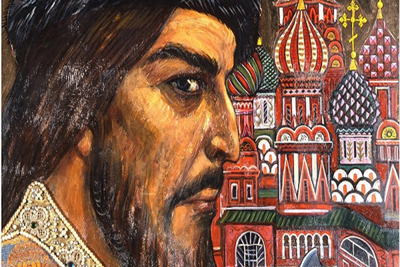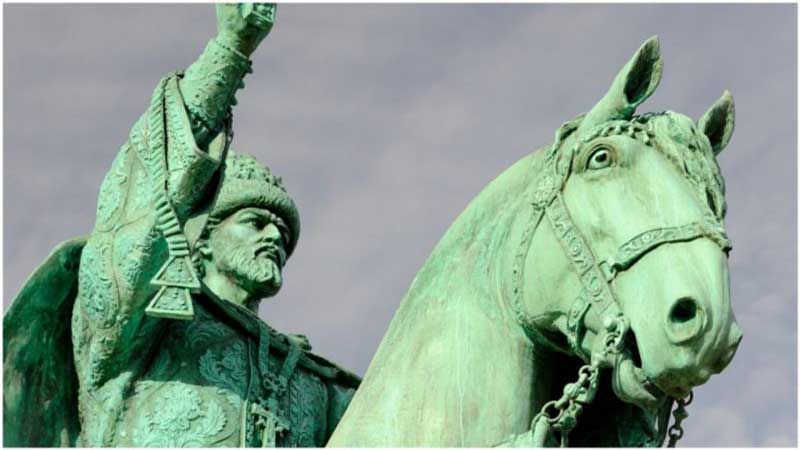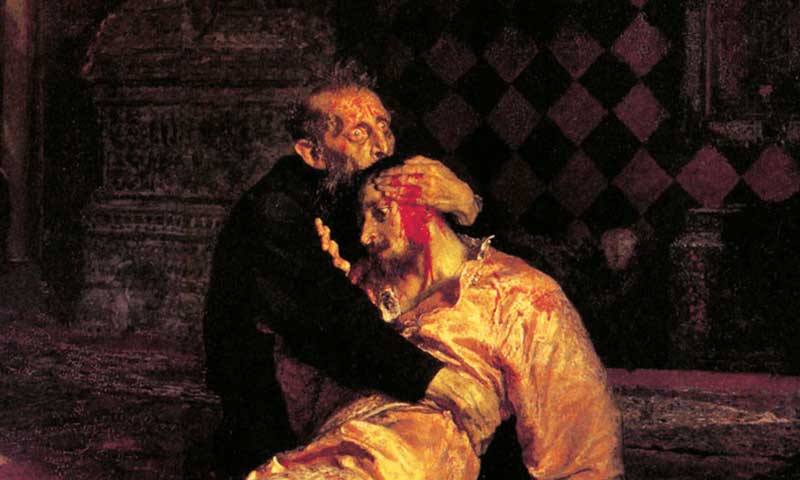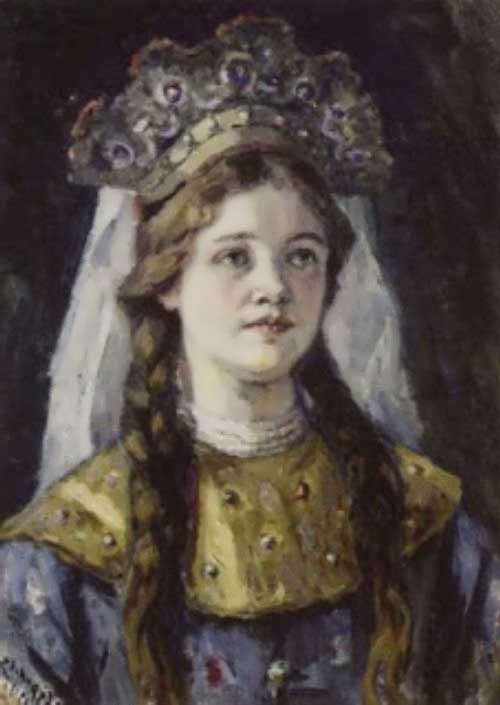
Ivan the Terrible, the grandson of Ivan the Great and one of the most outstanding personalities in Russian history, was born Ivan Chetvyorty Vasilyevich or Ivan IV on August 25, 1530, in the Grand Duchy of Muscovy, Russia. His father, Basil III, a member of the Rurik dynasty, died when Ivan was only three years old. In those days of political turmoil, his mother, Elena Glinskaya ruled as regent, but she died or assassinated by poisoning in 1538, when Ivan was only a boy of eight. During those early days of life, Ivan often felt neglected and scorned by the members of the nobility who looked after him. But, despite everything, he devoted much of his time to self-education. He used to read lot of books, which made him the most well-read ruler of those times. However, the continuous court intrigue and the constant danger of life molded much of his ruthless and suspicious nature. He started to hate the Boyars or the nobles, whom he suspected of being involved in his mother's death. However, on 16 January 1547, at age sixteen, Ivan IV was crowned as the Tsar of Muscovy at the Cathedral of the Dormition. He was the first Tsar of all Russia, he kept the title until his death in 1584, and all his successors used the same title after him. He was the man, who transformed Russia from a medieval state into an empire with a centralized government for centuries to come.
The early part of Ivan's reign was marked for peaceful reforms and modernization of the country. Within a short time after his crowning, Ivan revised the law codes, reformed tax collection, founded a standing army, established the first Russian parliament of the feudal Estates type and introduced the Chosen Council, the council of the nobles. Since his early days, Ivan hated the Boyars and in 1556, he instituted regulations on the obligations of the boyar class in the service of the crown. He introduced self-government in the rural regions, confirmed the position of the Church and unified the rituals and ecclesiastical regulations of the whole country. He also took the initiative to organize trade relations with England in 1553.

During the early days of Ivan, the Tartar khanates of Kazan and Astrakhan raided the northeast of Russia repeatedly. After settling the domestic issues, Ivan intended to resist the Mongol Golden Horde and to gain access to the Baltic Sea. However, his ultimate aim was to conquer all the independent regions and create a larger and centralized Russia. Finally, on 16 June 1552 he led a huge Russian army of 150,000 towards Kazan and the last siege of the Tatar capital commenced on 30 August. With the help of his efficient military engineers, he blocked the water supply of the city and breached the walls. Kazan finally fell on 2 October and by the order of Ivan IV, its fortifications were razed, women were raped and much of the population massacred. Nearly 100,000 Russians, who were held as prisoners were released along with the slaves.
This victory over the Kazan extended Muscovy control to the Urals in the east and the Caspian Sea in the south and thus it created a buffer zone against the attacking Mongols. Ivan also tried to annex Lithuania and gaining access to the Baltic. But, he failed and his army was defeated, as one of his advisers defected to Lithuania and led its army against the Tsar.

Nevertheless, to celebrate this great victory, the Tsar constructed the famous Saint Basil’s Cathedral on Red Square in Moscow and was very much impressed with its architectural beauty. It is alleged that, Ivan ordered to blind the architect, Postnik Yakovlev, so that he could never design for any other person and anything more beautiful than the Saint Basil’s Cathedral. However, it is not true. After Saint Basil’s, Postnik Yakovlev designed many more churches for Ivan and also the walls of the Kazan Kremlin in the early 1560s.
Russia was in deep trouble in 1560, due to a combination of drought and famine, unsuccessful wars and the sea-trading blockade carried out by the Swedes and Poles. During the same year, Ivan IV lost his first wife, Anastasia Romanovna and her death was suspected to be a case of poisoning. This personal tragedy caused a deep depression in Ivan and his behavior became more erratic. He suspected that she had been murdered by the Boyars and it made Ivan paranoid and suspicious of the nobility. All of a sudden, he deserted Moscow and threatened to abdicate the throne. However, the Boyar court was not comfortable about the idea to rule the country in Ivan's absence and apprehended the wrath of the Muscovite citizenry. Consequently, a Boyar envoy departed for Aleksandrova Sloboda to meet Ivan and begged him to return to the throne. He agreed to return on the condition of being granted absolute power in a created region around Moscow, to be known as the ‘Oprichnina’, where he should be able to punish and execute the traitors and the law breakers and confiscate their property, without any interference from the Boyar council or the church. Equipped with absolute authority, Ivan IV conducted a reign of terror over the next 24 years and earned his nickname, Ivan the Terrible. Primarily, he targeted the princely clans of Russia. He executed or exiled the prominent members of the Boyar clans on questionable accusations of conspiracy or marked them by shaving some or all of the hair on the scalp. He seized the private lands and redistributed them among his supporters and also introduced laws restricting the mobility of the peasants, which would later lead to serfdom. Ivan also created a personal force known as the 'Oprichniki', the first official secret Russian police force. They were given large estates, but were not accountable for their actions. Those men took everything from the peasants and forced them to pay exorbitant taxes. The excessive degree of oppression resulted in increasing cases of peasants fleeing, which in turn led to a drop in the overall production.

Apart from the oppression of the Oprichniki and the consequent famine, conditions were further worsened by the 1570 epidemic of Plague that killed 10,000 people in Novgorod alone. People were also dying in huge numbers in Moscow. The grim economic condition of the country, along with the cloud of the ongoing Livonian War, suddenly made Ivan suspicious that noblemen of the wealthy city of Novgorod may take the opportunity of the situation and may be planning to defect, placing the city itself into the control of the Grand Duchy of Lithuania. Immediately he ordered his force to raid the city of Novgorod, plunder and burn it, along with the surrounding villages. It is said that the massacre lasted for five weeks and it consisted of men, women and children that were tied to sleighs, then run into the freezing waters of the River Volkhov. Thousands of its inhabitants were tortured and butchered, even the archbishop was also hunted to death, on the basis of unproved accusations of treason.
During that period of terror, probably Ivan became mentally ill and sometimes behaved violently. In one of his violent outbursts, he frenziedly beat his pregnant daughter-in-law for wearing immodest clothing, causing a miscarriage. Consequently, he also killed his second son, also named Ivan, by striking on his head with his pointed staff, as he protested his father’s action of physically assaulting his sister-in-law. The episode was depicted in a famous painting by Ilya Repin: Ivan the Terrible and His Son Ivan.

Ivan the Terrible was a man of contradictions. Contrary to his image of a ruthless ruler, he was a poet, a composer of considerable talent, and supported arts and architecture. Though he was an orthodox Christian and according to the laws of the Russian Orthodox Church a fourth marriage is forbidden and impious, Ivan married for the fourth time in 1572, without the blessings of the church. It is said that, the great and terrible king had corrupted a thousand virgins. In fact, he had several dozen concubines and eight wives.

Ivan was crowned in 1547 at the age of16 and he married Anastasia Romanovna Zakharyina -Yurieva, two weeks later. It is said that, Anastasia was selected by Ivan out of 1,500 potential brides who were brought to him by the nobles from all corners of Russia. She was the only person, whose presence could soothe and calm his erratic and explosive nature. They remained together for thirteen years, until Anastasia’s death. They had six children, of whom four died at a very young age. In the summer of 1560, Anastasia fell very ill and despite the best possible medical attention, her health showed no sign of improvement. She died at the end of that summer and her death evoked Ivan’s first blasts of paranoia. He blindly blamed the Russian Boyars for her untimely death, suggesting that the nobles made a plot to poison him, but his wife became the accidental victim. Since his childhood Ivan disliked the Boyars and after making himself convinced by the conception of a plot, his hatred for the nobles reached at the boiling point. Without any hesitation, he ordered to torture and execute a number of apparently innocent people. That was beginning of turning his image to become terrible. It is interesting to note that the modern research has suggested that Anastasia might have been an actual victim of mercury poisoning, as traces of the element was found in high concentration in the Tsarina's hair.

It is said that Anastasia in her death bed requested Ivan to not wed a pagan. Yet, after her death Ivan Married Maria Cherkasskaya Temryukovna, the daughter of a Muslim prince. In fact, he was lured and sexually attracted by Maria’s extraordinary youthful beauty. But, she never truly fitted into the royal family. She failed to be a good stepmother and was not respected by anyone because of her character. She was illiterate, vindictive and cunning. She loved to watch executions, which gave her a strange pleasure. She had the ability to turn his husband against people she disliked. Naturally, she was generally hated by her subjects, who believed her to be manipulative and witch-like in her behavior. She bore Ivan one son who died just a few months after birth. Her death in 1569 was again a suspected case of poisoning, which was allegedly organized by her husband. However, this time again, the Tsar followed the same ritual that he did after the death of his first wife and again prepared a long list of people to torture, torment and finally brutally annihilate, only now for the death of his second wife.

Ivan spent two long years in quest of a suitable woman for his third wife and the quest ended when he found the19-year-old Marfa Vasilevna Sobakina, a girl raised in a merchant family. They were married on 28 October 1571, but Marfa’s stint as Tsarina was very short, as within a few days after the wedding, she fell sick and died on 13 November 1571. Some assume that she was forced to take a fertility potion, which poisoned her.

To bring peace to his suffering soul the Russian Tsar married Anna Alexeievna Koltovskaya, the daughter of Alexei Koltovski, a courtesan, on 29 April 1572. As a fourth marriage is forbidden and impious according to the laws of the Russian Orthodox Church, Ivan used the excuse that he did not consummate his marriage to Marfa and married Ana Alexeievna without the blessings of the church. But, as Ivan became impatient and Anna did not conceive, she was judged infertile and sent to a monastery, where she was later canonized as Saint Daria.

Ivan married Anna Vasilchikova in January 1575. Though the details are very scarce, but this marriage ended in 1576 and this wife was also consigned to a monastery. It is said that, as ordered by her husband, she was killed shortly after she was escorted out of the royal home. It is also said that, actually the healthy girl suddenly died of a deadly breast disease. However, why her body was secretly taken out from the palace at night and was sent to a Suzdal Nunnery for burial is a mystery.


The episode of Vasilisa Melentyeva, the sixth and the legendary wife of Ivan, might be fictitious, an invented story dating from the 19th century. It is also possible that she was one of the concubines of Ivan. The story goes that, Vasilisa, a wife of Nikita Melentyev was quite aware that Ivan is strongly attracted by her beauty. Soon after the death of her husband, she appeared in the palace in 1579 and readily became the new companion of Ivan. She wanted to become a queen and the Tsar married her and they happily lived together for two tears. However, in the palace, she found a new love interest in another man, Prince Devletev. One day Ivan came in her bedroom in an odd time and found his wife with her lover. As soon as Ivan discovered that he was being cheated by his wife, she was sent to a nunnery. But before leaving the palace, she was forced to witness the painful execution of her lover. It is also said that the two were buried alive.

Though there is no evidence of her existence in medieval sources, Maria Dolgorukaya is said to be the seventh wife of Ivan IV. Their marriage, not authorized by the church, could have been celebrated in 1573 or 1580. It is said that, had a love affair and the feelings were so strong that they were secretly married. However, either she was revealed to have a lover, or on their first night together the Tsar became convinced that she was not a virgin. The Tsar was shocked, but this time he did not bother to send her to a monastery, instead he had her drowned.

At the age of 51, Ivan married his eighth and last wife, Maria Nagaya in 1581and after a year she gave birth to his son, Dmitry. For the time being, the Tsar was pleased with his beautiful new wife, but soon he became fed up with her bouts of sadness. He was thinking to divorce Maria Nagaya and get a new wife. Even, he suggested to Queen Elizabeth of England that he marry her relative Mary Hastings and divorce his wife Maria Nagaya. But it never materialized. Ivan the Terrible suddenly died on 18 March 1584, while playing chase. Maria would die 24 years after the death of Tsar Ivan, in 1608.
During his last year, Ivan the Terrible became obsessed with death. As his health was failing, he started to depend upon witches, alchemists and soothsayers. But nothing worked well and finally he died of an apparent stroke. He was buried next to his son in the Archangel Cathedral, located in the Moscow Kremlin.
